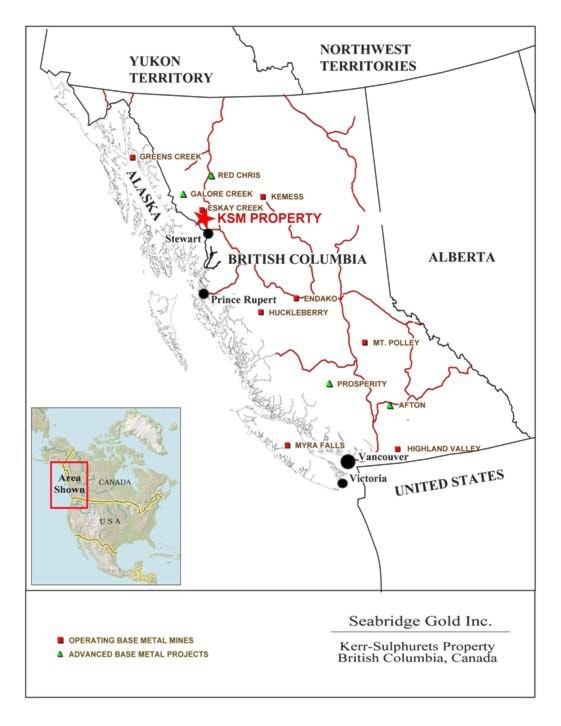Re: by the Canadian Press
Dear editor,
I am writing to express my surprise that Black Press Media publications would publish this article which suggests ‘some scientists’ are concerned that Seabridge Gold’s KSM project did not incorporate independent and peer-reviewed science during the environmental assessment and permitting process. To reiterate Jonathon Moore’s statement that “we want those scales rebalanced and the way to rebalance that is through peer-reviewed science and processes that are inclusive and incorporate cross-border policies” is completely contrary to the evidence and facts as it relates to the KSM Project.
In our view, by publishing this article, Black Press Media is suggesting the KSM Project’s independent joint-harmonized environmental review conducted under the British Columbia Government Environmental Assessment Act, the Canadian Environmental Assessment Act (1992) and under the Nisga’a Lisims Treaty, was not independent, peer-reviewed and did not incorporate cross-border policies and concerns; this illustrates a lack of comprehension about the independent scientific review and the regulatory process that the KSM Project underwent to be granted its environmental approvals.
As professional fact finders, I am confident that you will be interested in learning the facts about the science, peer, international cross border reviews and public consultations conducted before and during the independent environmental assessment review of Seabridge Gold’s KSM project.
Between 2008 and 2014, 250 independent scientists from across 20 disciplines along with a cadre of geophysical, geotechnical mining, design and civil engineers, social scientists and Indigenous traditional scientists worked together to research and publish 36,000 pages of scientifically rigorous findings as it relates to the environmental, economic, social, heritage, cumulative, international and health impacts of this project.
This review included information related to potential transboundary concerns and cross border policies. This information was then independently reviewed by both the Tahltan First Nation and Nisga’a Lisims’ scientists, who considered both the traditional scientific knowledge and traditional values as it related to the project, and further project accommodations were made at their request.
It’s important to note, not unlike research scientists, each of the scientists working on this project belong to and are licensed with professional regulatory bodies which regulate their practice through expected standards of practice and conduct.
Once the 36,000 pages of information were collected and collated, The Canadian Environmental Assessment Agency, The British Columbia Environmental Assessment Agency along with twenty US Federal and Alaska regulatory agencies, including the EPA who were mentioned in the article, and the Nisga’a Lisims’ Government conducted extensive, independent reviews of the information. During this time, Seabridge Gold scientists conducted 115 meetings with these independent regulators to answer questions about their peer review of the science. In contrast to what the article suggests, the US EPA and Alaska regulators were at the table for these meetings and Alaska citizens’ questions and comments were collected and responded to.
Concurrently, and as a prerequisite to permitting projects, Seabridge Gold was required to gain a social license to operate from the local communities and First Nation rights holders.
After a decade of consultation and engagement with the local community members and First Nations rights holders, responding to 15,000 questions and comments, 76 percent of the local community members strongly supported the KSM project environmental assessment application. Additionally, both the Tahltan Nation and the Nisga’a Lisims Nation (the First Nations on whose traditional territory the KSM Project is located), signed economic benefit agreements in support of the KSM Project.
It is also important to note for the record, that after one of the most comprehensive environmental assessment ever undertaken in Canada and British Columbia, the Canadian Minister of the Environment, in her decision statement approving the KSM Project, stated: “The project is not likely to cause adverse environmental effects as defined in the former Act, taking into account the implementation of mitigation measures described in the report… the mitigation measures and follow up programs described in the Report are appropriate for the project.” Further, the British Columbia Ministers of Environment and Energy and Mines concluded, “the project will be constructed, operated and decommissioned in a way that ensures that no significant adverse effects are likely to occur.” The US (EPA) and Alaska regulators were “satisfied there would be no downstream or transboundary impacts.”
In a democracy, we certainly welcomed a debate that was strengthened with the involvement of Alaskans, but there are legal and regulatory processes that we followed during the environmental assessment of the KSM project, given that both the US and Canada are countries founded on the “rule of law.” With the environmental assessment approvals of the project granted, it will now be up to the operator of the project who will be required by law to live up to the mitigation measures prescribed to ensure this project is developed and operated safely and does not have adverse effects on the environment.
As a scientist, given the 36,000 pages of research compiled by over 250 independent scientists, the seven-year independent, peer regulatory review, three independent science reviews, over 15,000 conversations and our two First Nation partners’ approval for the project, I am genuinely disappointed by the false information perpetrated by publishing the unsubstantiated suggestion that the KSM project did not undergo a comprehensive, transparent peer-reviewed environmental assessment which did not take cross boundary policies into consideration.
My professional science training taught me that good science happens through factual and evidence-based decision-making. I am also under the impression good journalism happens when both sides of the story are told and, I hope, in the future, we can all expect that Black Press Media will live up to these professional standards when reporting on Seabridge Gold’s KSM Project.
R Brent Murphy, senior vice president of environmental affairs for Seabridge Gold



